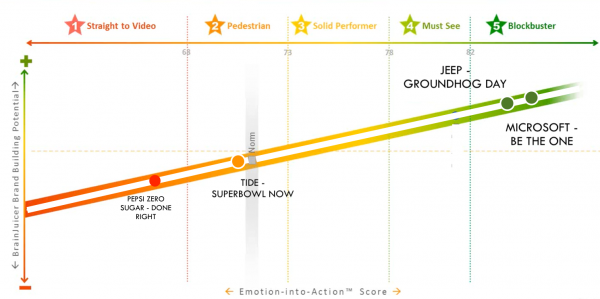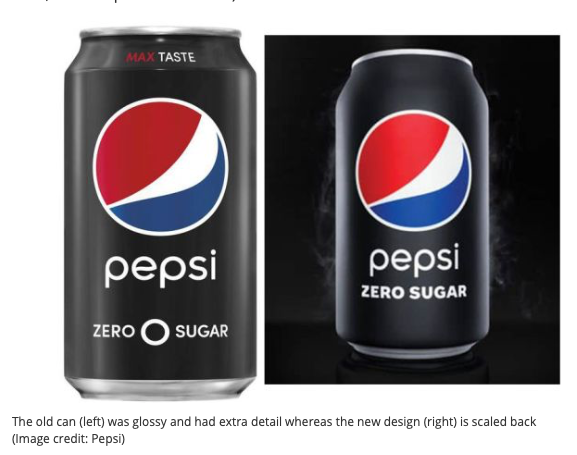So, who won the Super Bowl on Sunday night? No, not the Kansas City Chiefs, that was just the football game. I’m talking about the trophy that really matters: the most effective ad from the 58 that ran on the evening! In this post I draw on testing data (1) from one of our network of partner insight agencies, System 1, to answer this question and draw out some lessons.
System 1 use ‘implicit’ methods of testing that tap into peoples’ emotions to assess the likely effectiveness of an ad. Below we look at four ads which range from poor (1*) to average (2*) to Superbowl winners (5*). The winners combined emotional ‘sizzle’ and product ‘sausage’, in addition to better integrating celebrities.

Winner – Microsoft
Microsoft’s ad, like all four ads covered here, made use of a celebrity to create impact and tap into ‘borrowed memory structure’: by featuring someone famous, the brand hopes to associate itself with the same values and attributes. The ad stars Katie Sowers, the San Francisco 49ers Assistant Offensive Coach, who made history by being the first woman to ever coach in the Super Bowl.
What it does well:
- The celebrity is integrated into the ad, with the film showing Katie telling her story in her own words in addition to drawing on archive footage
- The film tells an inspirational story of Katie’s progress with an emotionally uplifting message, urging viewers to “Be The One” who opens up opportunities for others.
- There is also some integration of the product, via Katie using her Microsoft Surface as a tool in her coaching
https://www.youtube.com/watch?time_continue=1&v=_xPn4DXIj5w&feature=emb_logo
I wonder if Microsoft did miss a trick by not making more of the idea “When you have a dream, bring it to the Surface,” which is mentioned in the text on YouTube and was featured in a previous Microsoft ad. I guess that for the Super Bowl they wanted more of a masterbrand message (Be the One) versus a product message.
https://www.youtube.com/watch?v=Nr5WmsXJAm0
Runner up – Jeep
Jeep also use celebrity but in a different way, with Bill Murray replaying his role in the movie Groundhog Day. Murray’s looped life is made more enjoyable by a Jeep Gladiator that he drives on different adventures each day.
What it does well:
- Again, the celebrity is well integrated into the ad, with Bill Murray playing an active and relevant role.
- The film tells an emotional story of how the Jeep helps make Murray’s recurring day enjoyable not painful, with plenty of humour, tapping into the feel-good memory structure associated with movie.
- The Jeep ad does an even better job of integrating the product, via the adventures Murray has in the Jeep with his groundhog pal, doing a good job of communicating the brand idea: “For dreamers and doers – forging extraordinary bonds between themselves and their owners, because adventure is found in every Jeep vehicle’s DNA” (2)
https://www.youtube.com/watch?v=AnhzGUcENWo&feature=emb_logo
Middle of the road
Tide’s ad for Power Pods scored a mediocre 2.7* placing it bang in the average spot. Again, it features celebrities in the form of actor Charlie Day and actress Emily Hampshire (as a Brit I had to Google them).
What it does less well:
- Here celebrities seemed forced into the ad, acting up and feeling much less authentic than in the Microsoft and Jeep ads
- The story has less emotional pulling power in my view, with a rather clunky storyline about Emily staining Charlie’s shirt in a staged, slapstick fashion and him then worrying about when the shirt will get cleaned. The brand commentary on Tide’s YouTube page also feels culturally out of touch: “Charlie tries to figure it out while Emily knows new Tide POWER PODS® will get it out whenever SHE gets around to it. Like later.” Yikes.
- Surprisingly for my old company P&G, the product integration also feels weak. It makes a classic error we were trained to avoid at P&G: putting all the drama on the problem (the stain) rather than on the benefit of a clean shirt.
https://www.youtube.com/watch?v=mPrLiNseyCc
Bottom of the class
Poor old Pepsi Zero Sugar managed to blow a boatload of cash on an ad stuck way down at the bottom of the scoreboard with a 1.5* score putting it 57th out of 59 ads tested.
What it does poorly:
- The Pepsi ad the celebrities are just for show, withMissy Elliott and H.E.R. performing “a new take on an iconic track”
- There is no real story to create emotion, reflected in the 1* System 1 score…
- … what little story there is features the product in a forced way, by showing a Coke-like red can being transformed into a black Pepsi Zero Sugar pack
https://www.youtube.com/watch?v=ddADu4-A7Io
The brand’s YouTube page claims that the pack “is looking better than ever”, and on exploration I found that the ad is trumpeting a new design for Pepsi Zero Sugar, which may partly explain the lack of story: its a classic example of ‘spot the difference’ pack re-design, and not one that seems to justify an expensive celebrity-endorsed Super Bowl ad!

In conclusion, System 1’s Super Bowl league table shows how effective ads tend to come from telling a product story in a an emotionally involving way, ensuring that any costly celebrities are integrated into the story in an authentic way that taps into their borrowed memory structure.

Sources:
(1) https://system1group.com/superbowl
(2) https://www.youtube.com/watch?v=AnhzGUcENWo&feature=emb_logo
